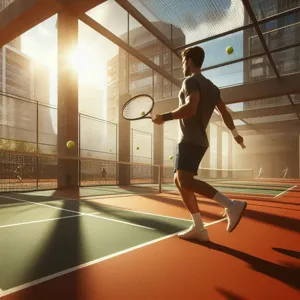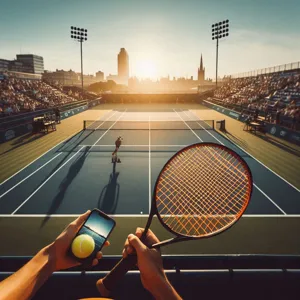A clean car interior is more than just a matter of aesthetics; it’s about creating a comfortable and enjoyable driving experience.
After all, your vehicle is a personal sanctuary where many of life’s moments unfold, from daily commutes to weekend getaways. However, between spilled coffee, crumbs from snacks, and the inevitable dust and dirt that accumulate over time, keeping your car’s interior spotless can feel like a daunting task. Fear not! In this ultimate guide, we’ll share expert tips and tricks to transform your car’s interior into a pristine haven. Whether you’re a meticulous car enthusiast or just looking to tidy up for a special occasion, our comprehensive advice will help you tackle every nook and cranny, ensuring your ride not only looks great but feels great too. Get ready to roll in style and comfort as we dive into the essentials of car interior cleaning!
1. Introduction: The Importance of a Clean Car Interior
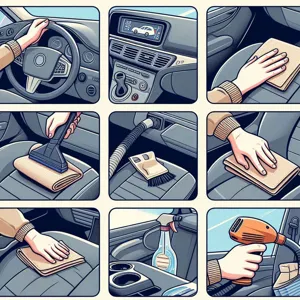
A clean car interior is more than just a matter of aesthetics; it plays a crucial role in enhancing your driving experience and maintaining the longevity of your vehicle. Picture this: you step into your car after a long day, and instead of being greeted by a fresh, inviting space, you find yourself surrounded by crumbs, stains, and a lingering odor. Not only can a cluttered environment be distracting, but it can also negatively impact your mood and overall comfort while driving.
A spotless interior gives a sense of pride and ownership, reflecting your personality and attention to detail. Moreover, regular cleaning can help preserve the materials in your car, preventing wear and tear that can lead to costly repairs down the line. Dust and dirt can accumulate on surfaces, leading to scratches and fading if left unchecked. By investing time in cleaning your car, you’re not only creating a pleasant environment for yourself but also safeguarding your investment.
Additionally, a clean car interior can improve your health. Dust, allergens, and bacteria can thrive in neglected spaces, potentially exacerbating allergies or respiratory issues. Keeping your car tidy helps create a healthier atmosphere, ensuring that every drive is not only enjoyable but also safe for you and your passengers.
In this ultimate guide, we’ll explore practical tips and tricks to help you achieve a spotless ride. From the best cleaning supplies to effective techniques for tackling even the messiest of interiors, we’ve got you covered. So, roll up your sleeves, and let’s transform your vehicle into a pristine sanctuary on wheels!
2. Essential Cleaning Supplies You Need
To achieve a spotless car interior, having the right cleaning supplies on hand is essential. Before you dive into the nitty-gritty of scrubbing and polishing, take a moment to gather these indispensable items that will make your cleaning process efficient and effective.
First on your list should be a high-quality vacuum cleaner. Opt for one with specialized attachments for reaching those tricky spots between seats and under mats. A handheld vacuum can be particularly handy for quick clean-ups, ensuring you can tackle dirt and crumbs as they accumulate.
Next, consider microfiber cloths, which are gentle on surfaces yet highly effective at picking up dust and grime. Unlike traditional rags, microfiber cloths won’t scratch your dashboard or windows, making them perfect for a variety of surfaces throughout your car. Stock up on several in different colors to designate specific uses—such as one for the dashboard, another for glass, and so on.
Don’t forget a good all-purpose cleaner or a specialized interior cleaner suited for your car’s materials. Whether your seats are leather, fabric, or vinyl, using the right product will help lift stains without causing damage. For those tough spots, a soft-bristle brush can work wonders, especially in fabric upholstery.
For the finishing touches, a glass cleaner is essential for achieving crystal-clear windows, and an air freshener will help keep your car smelling fresh after all your hard work. Lastly, consider a protective spray for your dashboard and other plastic surfaces to help repel dust and prevent fading from UV exposure.
With these essential supplies at your disposal, you’ll be well-equipped to tackle any mess and maintain a pristine car interior that you can be proud of. Happy cleaning!
3. Preparing Your Car for Cleaning
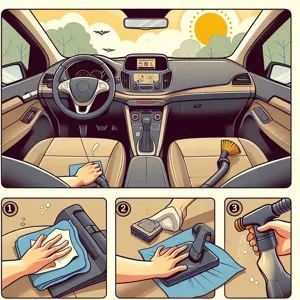
Before diving into the nitty-gritty of cleaning your car interior, it’s essential to prepare your vehicle properly. This initial step sets the stage for a more efficient and thorough cleaning experience. Start by removing any obvious clutter—think of it as decluttering your car’s living space. Remove personal items, trash, and any loose belongings that have settled into your vehicle over time. Don’t forget to check under the seats and in the glove compartment, as these are often overlooked areas where forgotten items accumulate.
Next, take the time to vacuum the interior, focusing on the carpets, seats, and floor mats. Use a handheld vacuum or a vacuum attachment with a crevice tool to reach those tricky spots between the seats and in the corners. This will help eliminate dirt, dust, and debris, ensuring a clean slate for the next steps. If your car has removable floor mats, take them out and give them a good shake or vacuum separately.
Once you’ve cleared out the clutter and debris, inspect the surfaces of your car’s interior. This includes the dashboard, steering wheel, door panels, and center console. Take a moment to assess any stains or specific problem areas that might require special attention, such as spills on the upholstery or scuff marks on the plastic. Having a clear idea of what needs addressing will allow you to tailor your cleaning strategy effectively.
Finally, gather all the cleaning supplies you’ll need. Depending on your car’s materials, you may require microfiber cloths, upholstery cleaner, glass cleaner, and a dedicated dashboard polish. By organizing your cleaning tools ahead of time, you’ll streamline the process and avoid unnecessary interruptions. With your car prepared and your supplies at the ready, you’re now set to transform your vehicle’s interior into a pristine haven.
4. Vacuuming Your Car: Techniques for Maximum Cleanliness
Vacuuming your car might seem like a straightforward task, but employing the right techniques can make a world of difference in achieving that immaculate interior you desire. To start, ensure you have a powerful vacuum with multiple attachments—this will allow you to reach every nook and cranny of your vehicle. A handheld vacuum or one with a hose is particularly effective for getting into tight spaces, such as between seats and into cup holders.
Begin by removing any loose items from your car, such as trash, bags, and personal belongings. This will provide unobstructed access to the surfaces that need cleaning. Next, give the carpets and upholstery a good shake to dislodge any trapped debris. When you start vacuuming, begin from the top of the interior and work your way down. This approach ensures that any dust or crumbs that fall onto lower surfaces are picked up immediately, preventing the need for multiple passes.
As you vacuum, pay special attention to high-traffic areas—like the driver’s seat and floor mats—where dirt tends to accumulate. Use the crevice tool to tackle those hard-to-reach spots, such as the gap between the seats and the console. Don’t forget about the dashboard and door panels; a quick run over these surfaces can help remove dust and prevent it from settling back onto your freshly vacuumed seats.
For an extra touch, consider using an upholstery attachment to gently clean the fabric and a soft brush for leather surfaces. This not only removes dirt but also revives the texture and appearance of your upholstery. To finish off, take a moment to vacuum the trunk and any storage compartments, as these areas often trap unwanted debris as well.
With these techniques in mind, you’ll not only achieve maximum cleanliness but also maintain the overall value and aesthetics of your vehicle, leaving you with a ride that feels as good as new.
5. Cleaning the Dashboard and Console
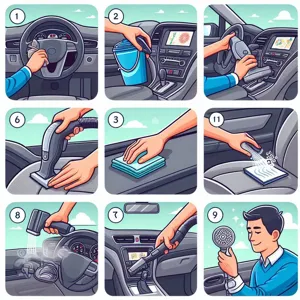
Cleaning the dashboard and console is a crucial step in achieving a spotless car interior, as these surfaces often accumulate dust, grime, and fingerprints over time. To start, gather your supplies: a microfiber cloth, a soft-bristle brush, and a gentle cleaning solution. It’s essential to choose a cleaner that is safe for the materials in your car, whether they are plastic, vinyl, or metal.
Begin by removing any loose items from the dashboard and console to create a clear workspace. Use the soft-bristle brush to gently dislodge any dust or debris from the crevices and seams. This step is particularly important for areas around air vents and knobs, where dirt can easily build up and become difficult to reach.
Next, dampen the microfiber cloth with your chosen cleaning solution. Avoid saturating it; a lightly damp cloth will effectively pick up dirt without leaving excess moisture that could seep into electronics. Wipe the dashboard in a circular motion, ensuring that you cover every inch, from the instrument cluster to the glove compartment. Pay special attention to areas that are often overlooked, such as the edges and corners where dust tends to accumulate.
For the console, which may have more textured surfaces, use a brush to reach into the grooves and around buttons. After wiping down both the dashboard and console, take a dry section of the microfiber cloth to buff away any streaks or residue.
Finally, consider applying a protectant designed for automotive plastics and vinyl. This not only gives your surfaces a polished look but also adds a layer of UV protection to prevent fading and cracking over time. By following these steps, your dashboard and console will not only look pristine but will also enhance your overall driving experience, making every journey more enjoyable.
6. Upholstery Care: Tips for Cloth and Leather Seats
When it comes to maintaining a pristine car interior, upholstery care is essential, especially for cloth and leather seats. each material requires a tailored approach to ensure longevity and aesthetic appeal.
**For Cloth Seats:** Start by vacuuming to eliminate crumbs, dust, and dirt particles that settle into the fibers. Use an upholstery attachment to reach the crevices and corners. Once the vacuuming is complete, treat stains with a fabric cleaner specifically designed for automotive use. Spray a small amount onto the stain and gently blot with a microfiber cloth, avoiding vigorous rubbing which can damage the fabric. For deeper cleaning, consider using a steam cleaner or a carpet cleaner with upholstery capabilities, which can lift embedded grime without harsh chemicals.
**For Leather Seats:** Leather requires a more delicate touch. Begin by vacuuming to remove debris, and then wipe down the surface with a soft, damp cloth to remove surface dust. Avoid soaking the leather; instead, use a gentle pH-balanced leather cleaner. Apply the cleaner to a microfiber cloth and work it into the seats using circular motions, paying special attention to seams and creases where dirt tends to accumulate. After cleaning, don’t forget to condition the leather with a quality leather conditioner to maintain its suppleness and prevent cracking. Conditioning should be done every three to six months, depending on your climate and usage.
By tailoring your cleaning routine to the specific needs of cloth and leather upholstery, you can keep your car interior looking fresh and inviting, making every drive a delightful experience. Regular maintenance not only enhances the visual appeal of your vehicle but also preserves its value over time. Remember, a clean interior is not just about aesthetics; it contributes significantly to your overall driving comfort.
7. How to Clean Windows and Mirrors
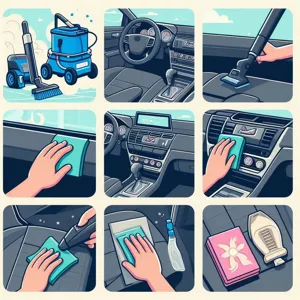
Cleaning your car windows and mirrors is an essential step in maintaining a spotless interior, not only for aesthetic reasons but also for safety. Dirty windows can obscure your view, especially in bright sunlight or inclement weather, so keeping them crystal clear should be a priority.
Start by choosing the right cleaning solution. While store-bought glass cleaners are effective, you can also create an eco-friendly diy version by mixing equal parts of water and white vinegar in a spray bottle. This solution cuts through grime and leaves a streak-free finish.
Before you begin, gather your supplies: a microfiber cloth, a soft sponge, and a squeegee if you have one. Microfiber cloths are especially beneficial as they trap dust and dirt without scratching the glass surface. Avoid using paper towels, as they can leave lint behind and may scratch the glass.
Begin by rolling down your windows slightly to access the top edge, where dirt tends to accumulate. Spray your chosen cleaner onto the glass, starting from the top and working your way down. This method prevents any drips from running down onto already cleaned areas. Use the microfiber cloth to wipe the surface in a circular motion, ensuring you cover all corners and edges.
For a flawless finish, use a squeegee to remove any excess cleaner. Start at the top corner of the window and pull the squeegee down in a straight line, wiping the blade with the cloth after each pass to avoid spreading dirt back onto the glass. Don’t forget to clean the inside of the windows as well, as these can accumulate fingerprints and smudges over time.
For mirrors, use the same cleaning solution and technique. Make sure to tackle both the front and back of the mirrors, ensuring they’re free from streaks and smudges.
Finally, take a step back and admire your work. Clean windows and mirrors not only enhance the overall appearance of your car’s interior but also improve your visibility and safety on the road. Regularly cleaning these surfaces will keep your ride looking fresh and ensure that you enjoy a clear view every time you hit the road.
8. Detailing Your Car’s Carpets and Floor Mats
When it comes to achieving a truly spotless interior, detailing your car’s carpets and floor mats is a crucial step that often gets overlooked. These areas not only bear the brunt of everyday wear and tear but also accumulate dirt, grime, and spills that can detract from the overall cleanliness and appeal of your vehicle.
Start by removing the floor mats from your car. Shake them vigorously to dislodge any loose debris, and then give them a thorough vacuuming to capture the finer particles that may be lurking in the fibers. If your mats are rubber, don’t hesitate to use a hose with a gentle spray to wash away stubborn muck. For fabric mats, a specialized carpet cleaner can work wonders. Spray the cleaner evenly across the surface, allowing it to penetrate for a few minutes, then scrub with a soft-bristled brush to lift the dirt away. Rinse thoroughly and let them air dry completely before placing them back in your vehicle.
Once the mats are clean, turn your attention to the carpets. Begin by vacuuming the entire area, paying special attention to the corners, under the seats, and any crevices where dirt tends to hide. For deep cleaning, consider using a steam cleaner or a carpet cleaner machine, which can effectively target embedded stains and odors. If you encounter tough stains—like coffee spills or mud—apply a spot treatment designed for automotive carpets, and blot with a clean cloth until the stain lifts.
Don’t forget to finish with a fabric refresher or an odor-eliminating spray to leave your car smelling fresh. Detailing your carpets and floor mats not only enhances the appearance of your interior but also contributes to a more pleasant driving experience, ensuring that every ride feels as good as new.
9. Freshening Up Odors: Deodorizing Tips
A clean car interior is not just about the absence of dirt; it’s also about creating an inviting atmosphere free from unpleasant odors. Over time, your vehicle can accumulate a variety of smells—from lingering fast food wrappers to musty air fresheners. Fortunately, freshening up your car’s interior is simple and can make a world of difference in your driving experience. Here are some effective deodorizing tips to ensure your ride smells as good as it looks.
**1. Deep Clean Your Upholstery:** Start with a thorough cleaning of your seats and carpets. Use a vacuum to remove any crumbs and debris, then follow up with an appropriate cleaner for your upholstery type—be it fabric or leather. For fabric seats, consider using a steam cleaner or upholstery cleaner to lift stubborn stains and odors.
**2. Natural Deodorizers:** Harness the power of natural ingredients to combat odors. baking soda is a fantastic odor absorber—sprinkle it on seats and carpets, let it sit for a few hours (or overnight), and then vacuum it away. Activated charcoal bags are another excellent option; they can absorb moisture and odors without any added fragrances.
**3. Air Out the Space:** Sometimes, all your car needs is a good airing out. On a dry day, park your vehicle in a shaded area with the windows rolled down. This allows fresh air to circulate and helps dissipate any stale smells that may have developed over time.
**4. Essential Oils and DIY Sprays:** If you prefer a pleasant scent, consider making a DIY air freshener with essential oils. Mix water with a few drops of your favorite essential oil (like lavender, lemon, or eucalyptus) in a spray bottle. Lightly mist the interior, avoiding sensitive areas like electronic components. This method allows you to customize the fragrance while avoiding artificial scents often found in commercial air fresheners.
**5. Replace or Clean Your Cabin Air Filter:** A clogged cabin air filter can contribute to unpleasant odors in your car. Check your vehicle’s manual for information on how to locate and replace the filter. Cleaning it periodically can also help maintain fresh air circulation within the cabin.
By implementing these deodorizing tips, you can effectively banish unwanted odors and elevate your car’s interior ambiance. A fresh-smelling vehicle not only enhances your driving experience but also leaves a lasting impression on passengers. So go ahead, give your ride the rejuvenation it deserves!
10. Organizing Your Car: Keeping It Clutter-Free
A cluttered car interior can quickly transform your once-pristine vehicle into a chaotic mess, making it difficult to enjoy your rides or find essential items when you need them. To maintain a spotless ride, it’s vital to prioritize organization within your car. Start by decluttering regularly—set aside a few minutes each week to remove unwanted items, such as old receipts, empty water bottles, and miscellaneous junk that tends to accumulate.
Investing in organizational accessories can significantly enhance your car’s tidiness. Consider utilizing seatback organizers, console trays, and trunk storage bins to create designated spaces for various items. For instance, a seatback organizer can hold everything from snacks to gadgets, keeping them easily accessible yet out of the way. Similarly, a trunk storage bin can neatly house emergency supplies, sports equipment, or groceries, preventing them from rolling around and creating further mess.
Additionally, develop the habit of implementing a ‘one in, one out’ rule—every time you bring something new into your car, make it a point to remove an existing item. This practice not only helps maintain a clutter-free environment but also encourages mindfulness about what you carry.
Lastly, consider setting up a routine cleaning schedule where you take a few minutes after each trip to tidy up. A quick sweep to dispose of trash and reorganize items can go a long way in preserving that fresh, clean feel of your car’s interior. By adopting these simple yet effective strategies, you can enjoy a clutter-free space that elevates your driving experience and keeps your car looking its best.
11. Maintaining a Clean Interior: Regular Cleaning Routines
Maintaining a clean interior is crucial for both the aesthetic appeal and longevity of your vehicle. Regular cleaning routines not only prevent dirt and grime from accumulating but also create a more pleasant driving environment. To establish an effective cleaning regimen, consider incorporating these simple yet impactful practices into your routine.
Start by setting aside a specific day each month dedicated to a thorough interior clean. During this time, remove all items from your car, including floor mats and any personal belongings. Vacuuming should be your first step—make sure to reach all the nooks and crannies, including under the seats and in between the cushions. A good vacuum will pick up dirt, crumbs, and pet hair that often go unnoticed in daily commutes.
Next, focus on wiping down surfaces. Use a microfiber cloth and an appropriate cleaner to tackle the dashboard, steering wheel, and door panels. These areas can accumulate dust and fingerprints quickly, so regular attention will keep them looking pristine. Don’t forget to clean your glass surfaces; a streak-free cleaner will enhance visibility and give your interior a polished look.
Consider developing a quick weekly routine to maintain that fresh feel between deep cleans. This could include a simple vacuum of the floor mats, a quick wipe of the dashboard, and a dusting of any storage compartments. If you frequently eat in your car, keep a small trash bag handy to dispose of wrappers and containers immediately, preventing clutter from building up.
Lastly, invest in protective products that help keep your interior in top shape. Leather conditioners can prevent cracking and fading, while fabric protectors can help repel stains on upholstery. By establishing these regular cleaning routines, you’ll not only maintain a spotless ride but also enhance your driving experience, ensuring your car feels just as good as it looks.
12. Eco-Friendly Cleaning Solutions and Alternatives
When it comes to cleaning your car interior, eco-friendly cleaning solutions and alternatives are not just trendy—they’re a responsible choice for both your vehicle and the environment. With growing awareness of the impact of harsh chemicals, many car owners are now seeking natural alternatives that are effective yet gentle on surfaces and the air we breathe.
One of the simplest and most effective eco-friendly cleaning solutions can be made right at home: a mixture of equal parts vinegar and water. This powerful combination acts as a natural disinfectant that can cut through grease and grime on dashboards, door panels, and console surfaces without leaving harmful residues. For a fresh scent, consider adding a few drops of your favorite essential oil, like lavender or lemon, to the mix.
Baking soda is another versatile ally in your quest for a spotless ride. Its natural abrasive qualities make it perfect for tackling stubborn stains on upholstery. Just sprinkle a generous amount onto the stained area, let it sit for about 15 minutes to absorb odors and moisture, and then vacuum it up for a refreshed look. For leather seats, a solution of olive oil and vinegar can help condition and clean without the need for commercial leather products that often contain harsh chemicals.
For those looking to clean their carpets or floor mats, look no further than your pantry. Cornstarch can be sprinkled onto the mats to absorb grease and dirt. After letting it sit for a few hours, simply vacuum it away for a clean finish. Additionally, steam cleaning is an excellent chemical-free method for deep cleaning your upholstery and carpets, eliminating bacteria and allergens while preserving the integrity of the materials.
By opting for these eco-friendly solutions, not only will you maintain a clean and inviting car interior, but you’ll also contribute to a healthier planet. Your car will not only look good; it will feel good knowing you’ve made choices that are kind to both your family and the environment. So, gather those natural ingredients, roll up your sleeves, and enjoy the process of transforming your vehicle into a spotless sanctuary!
13. Dealing with Stubborn Stains: Techniques and Products
Stubborn stains can be the bane of a car owner’s existence, transforming a pristine interior into a battlefield of unsightly marks and blemishes. Whether it’s a spilled coffee, a muddy footprint, or an errant snack crumble, these stains require a strategic approach to restore your vehicle’s interior to its former glory.
**Techniques to Tackle Tough Stains:**
1. **Blot, Don’t Rub:** The first rule of stain removal is to blot the affected area gently with a clean cloth or paper towel. Rubbing can spread the stain further or grind it deeper into the fabric or upholstery. Start from the outside of the stain and work your way in to contain it.
2. **Pre-Treatment:** For fabric seats, consider using a fabric cleaner or a mixture of warm water and mild dish soap. Apply it to the stain, let it sit for a few minutes, and then blot with a clean cloth. For leather, a specialized leather cleaner is your best bet—apply it with a soft cloth and follow up with a leather conditioner to keep the material supple.
3. **Steam Cleaning:** If you have access to a steam cleaner, this can be a powerful tool against stubborn stains. The heat and moisture help lift dirt and grime from both fabric and leather. Just make sure to test a small, inconspicuous area first to avoid damage.
**Products That Pack a Punch:**
1. **Enzyme Cleaners:** These are particularly effective for organic stains like food and pet messes. Enzyme cleaners break down the organic material, making it easier to lift the stain from your car’s interior.
2. **Vinegar and Baking Soda:** A classic combination, vinegar can help dissolve stains while baking soda acts as a gentle abrasive. Create a paste with these two ingredients, apply it to the stain, and let it sit for 15-20 minutes before gently scrubbing and rinsing.
3. **Commercial Stain Removers:** There are many products specifically formulated for automotive interiors. Look for ones designed for your specific type of upholstery—whether fabric, vinyl, or leather. Always follow the manufacturer’s instructions for the best results.
4. **Magic Erasers:** These handy foam pads can work wonders on various surfaces, particularly hard plastics and leather. Just dampen one slightly and gently rub the stained area; the melamine foam will lift dirt and grime away.
By combining effective techniques with the right products, you can confidently tackle stubborn stains and keep your car interior looking immaculate. Remember, the key is to act quickly and use the appropriate method for the type of stain and surface to achieve a spotless ride!
14. Final Touches: Adding Personal Flair to Your Clean Car
After putting in the elbow grease to thoroughly clean your car interior, it’s time to add those final touches that transform your vehicle from merely tidy to truly personalized. This is where you can infuse your own style and make your car a reflection of who you are.
Start with the scent; a clean car should not only look good but also smell inviting. Consider using air fresheners that align with your preferences, whether you gravitate towards fresh linen, citrusy notes, or rich vanilla. You can also opt for natural alternatives like essential oils or even a small sachet filled with dried lavender or cedar chips. These not only add a pleasant aroma but also contribute to a calming atmosphere during your drives.
Next, think about organization. Invest in stylish organizers that fit your car’s aesthetic. A sleek, fabric trunk organizer can help keep your essentials in check, while a chic visor pouch can hold your sunglasses and tickets without cluttering your dashboard.
Don’t forget about the little extras, such as seat covers or steering wheel wraps that reflect your taste. Choose colors and patterns that resonate with your style—whether it’s vibrant and fun or sleek and sophisticated.
Finally, consider the finishing touch of personal mementos. A small photograph or a quirky keychain can add warmth and character. Just be sure to keep them secured to avoid distractions while driving.
By adding these personal flair elements, you not only enhance your car’s visual appeal but also create a comfortable and inviting space that feels uniquely yours. After all, your car is more than just a mode of transportation; it’s an extension of your personality.
15. Conclusion: Enjoying Your Spotless Ride and the Benefits of a Clean Interior
As we wrap up this ultimate guide to cleaning your car interior, it’s important to recognize that maintaining a spotless ride is not just about aesthetics; it’s about creating an enjoyable and healthy environment for you and your passengers. The satisfaction that comes from stepping into a clean, fresh-smelling car is unparalleled. Imagine sliding into your vehicle, greeted by the gleam of well-polished surfaces and the inviting scent of a thorough clean—an instant mood booster that can transform even the longest commutes into a pleasurable experience.
A clean car interior also offers a host of practical benefits. Regular cleaning helps protect your investment by preserving the quality of your upholstery and surfaces, preventing stains, and minimizing wear and tear. It can also enhance your safety; a clutter-free space reduces distractions while driving, allowing you to focus on the road ahead. Plus, a tidy interior is particularly important for maintaining good air quality, as dust and allergens can accumulate quickly in enclosed spaces.
By incorporating the tips and tricks outlined in this guide—ranging from effective vacuuming techniques to the best cleaning products for various surfaces—you’re well-equipped to tackle the dirt and grime that inevitably accumulates over time. Remember, consistency is key; making regular cleaning a part of your routine will ensure your car remains a welcoming sanctuary, ready for any adventure.
So, grab those microfiber cloths and eco-friendly cleaners, roll up your sleeves, and enjoy the process of giving your vehicle the care it deserves. Embrace the feeling of pride that comes with a spotless ride, and let it inspire you to keep your car in tip-top shape for years to come. After all, a clean interior not only enhances your driving experience but also reflects your personal style and attention to detail. Happy cleaning!
In conclusion, maintaining a spotless car interior not only enhances your driving experience but also preserves the longevity of your vehicle. By following the tips and tricks outlined in this ultimate guide, you can transform your car from cluttered to pristine with minimal effort. From the essential tools to the most effective techniques, we’ve covered all the bases to ensure that your ride reflects your style and care. So, roll up your sleeves, put on your favorite playlist, and tackle that interior cleaning task with confidence. With a little time and dedication, you’ll be rewarded with a fresh, inviting space that makes every journey a pleasure. Happy cleaning, and here’s to enjoying the drive in your beautifully maintained car!


